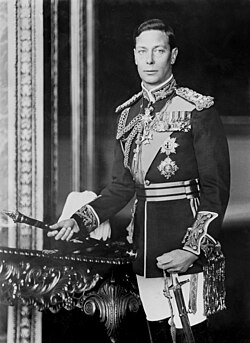George VI
Thank you for being part of the Bharatpedia family! 0% transparency: ₹0 raised out of ₹100,000 (0 supporter) |
| George VI | |||||
|---|---|---|---|---|---|
 Formal photograph, c. 1940–1946 | |||||
| King of the United Kingdom and the British Dominions (more...) | |||||
| Reign | 11 December 1936 – 6 February 1952 | ||||
| Coronation | 12 May 1937 | ||||
| Predecessor | Edward VIII | ||||
| Successor | Elizabeth II | ||||
| Emperor of India | |||||
| Reign | 11 December 1936 – 15 August 1947 | ||||
| Predecessor | Edward VIII | ||||
| Successor | Position abolished[lower-alpha 1] | ||||
| Born | Prince Albert of York 14 December 1895 York Cottage, Sandringham, Norfolk, England | ||||
| Died | 6 February 1952 (aged 56) Sandringham House, Norfolk | ||||
| Burial | 15 February 1952 | ||||
| Spouse | |||||
| Issue Detail | |||||
| |||||
| House |
| ||||
| Father | George V | ||||
| Mother | Mary of Teck | ||||
| Military career | |||||
| Service/ | |||||
| Years of service | 1913–1919 (active service) | ||||
| Battles/wars | |||||
George VI (14 December 1895 – 6 February 1952) was born Albert Frederick Arthur George Windsor.[1] He was the king of the United Kingdom from 11 December 1936 until he died on 6 February 1952. He became king when his older brother, Edward VIII, abdicated in 1936 to marry Wallis Simpson. George was married to Elizabeth Bowes-Lyon from April 1923 until his death.
He was succeeded as monarch by his elder daughter, Elizabeth.
George had a speech problem, a stutter.[2] This made it very difficult for him to carry out many of the public duties of a king which required him to make speeches. He was treated by an Australian speech and language therapist called Lionel Logue.[2] The story of this part of George's life was made into a movie in 2010 called The King's Speech.[2] Colin Firth played the role of George, and Geoffrey Rush played the role of Logue.
George became a very popular king throughout the British Empire. He won admiration during World War II (1939–1945), in which he stayed at Buckingham Palace during the most intense months of the Blitz. The Palace was bombed more than twice but he still remained, becoming a symbol of resistance and "fighting spirit". He enjoyed a close working relationship with his wartime Prime Minister Winston Churchill, inviting him to join the Royal Family on Victory in Europe Day (1945) to celebrate the defeat of the Nazis.
After World World II ended, his health began to decline which meant he couldn’t do many duties as king so Princess Elizabeth took them on in his place. A heavy smoker, George died of lung cancer and was given a state funeral. He was 56 years old.
British Prime Ministers[edit]
- Stanley Baldwin (1935–1937)
- Neville Chamberlain (1937–1940)
- Winston Churchill (first term, 1940–1945)
- Clement Attlee (1945–1951)
- Winston Churchill (second term, 1951–1952)
Family[edit]
George VI was the son of King George V and Queen Mary. He was the younger brother of Edward VIII, who gave up the throne to marry an American divorced woman, Wallis Simpson. In April 1923, George married his beloved wife Elizabeth, who later became known as Queen Elizabeth The Queen Mother. They had two children, Princesses Elizabeth (later Elizabeth II) born in 1926 and Margaret (1930–2002).
Death and funeral[edit]
George VI died on 6 February 1952.[3] Crowds began to gather in London in the early hours of the morning of the funeral. Thousands saw the event on television. Shortly after 9:00am, the funeral procession arrived at Westminster Hall. More than 300,000 people paid their respects to his body which lay in state for three days.
Notes[edit]
- ↑ George VI continued as titular Emperor of India until 22 June 1948.
References[edit]
- ↑ "No. 26689". The London Gazette. 14 December 1895. p. 7267.
- ↑ 2.0 2.1 2.2 "Stuttering and the King's Speech". Stutteringhelp.org. 2011 [last update]. Archived from the original on 14 March 2012. Retrieved 30 April 2011.
- ↑ "No. 39458". The London Gazette. 6 February 1952. p. 757.
